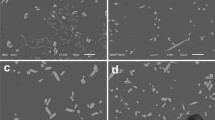Abstract.
Diffusion of Zr and zircon solubility in hydrous, containing approximately 4.5 wt% H2O, metaluminous granitic melts with halogens, either 0.35 wt% Cl (LCl) or 1.2 wt% F (MRF), and in a halogen-free melt (LCO) were measured at 1.0 GPa and temperatures between 1,050 and 1,400 °C in a piston-cylinder apparatus using the zircon dissolution technique. Arrhenius equations for Zr diffusion in each hydrous melt composition are, for LCO with 4.4±0.4 wt% H2O: \(D = 2.88 \pm 0.03x10^{ - 8} \exp \left( {{{ - 140.1 \pm 33.9} \over {RT}}} \right)\) , for LCl with 4.5±0.5 wt% H2O: \(D = 2.33 \pm 0.05x10^{ - 4} \exp \left( {{{ - 254.8 \pm 64.1} \over {RT}}} \right)\) and for MRF with 4.9±0.3 wt% H2O: \(D = 2.54 \pm 0.03x10^{ - 5} \exp \left( {{{ - 223.8 \pm 15.5} \over {RT}}} \right)\) .
Solubilities determined by the dissolution technique were reversed for LCO +4.5±0.5 wt% H2O by crystallization of a Zr-enriched glass of LCO composition at 1,200 and 1,050 °C at 1.0 GPa. The solubility data were used to calculate partition coefficients of Zr between zircon and hydrous melt, which are given by the following expressions: for LCO \(\ln D_{Zr}^{zircon/melt} = 1.63\left( {{{10000} \over T}} \right) - 5.87\) , for LCl \(\ln D_{Zr}^{zircon/melt} = 1.47\left( {{{10000} \over T}} \right) - 4.75\) and, for MRF by \(\ln D_{Zr}^{zircon/melt} = 1.47\left( {{{10000} \over T}} \right) - 4.91\) .
Experiments on the same compositions, but with water contents down to 0.5 wt%, demonstrated reductions in both the diffusion coefficient of Zr and zircon solubility in the melt. The addition of halogens at the concentration levels studied to metaluminous melts has a small effect on either the diffusion of Zr in the melt, or the solubility of zircon at all water concentrations and temperatures investigated. At 800 °C, the calculated diffusion coefficient of Zr is lowest in LCl, 9×10–17 m2 s–1, and is highest in LCO, 4×10–15 m2 s–1. Extrapolation of the halogen-free solubility data to a magmatic temperature of 800 °C yields solubilities of approximately one-third of those directly measured in similar compositions, predicted by earlier studies of zircon dissolution and based upon analyses of natural rocks. This discrepancy is attributed to the higher oxygen fugacity of the experiments of this study compared with previous studies and nature, and the effect of oxygen fugacity on the structural role of iron in the melt, which, in turn, affects zircon solubility, but does not significantly affect Zr diffusion.
Similar content being viewed by others
Author information
Authors and Affiliations
Additional information
Electronic Publication
Rights and permissions
About this article
Cite this article
Baker, D.R., Conte, A., Freda, C. et al. The effect of halogens on Zr diffusion and zircon dissolution in hydrous metaluminous granitic melts. Contrib Mineral Petrol 142, 666–678 (2002). https://doi.org/10.1007/s00410-001-0328-3
Received:
Accepted:
Published:
Issue Date:
DOI: https://doi.org/10.1007/s00410-001-0328-3




